Terada Honke Okura Festa (Sake Festival) 2018! Visited Sake Brewery, too!!
Visiting Terada Honke Sake Brewery
Finally I got to Terada Honke!


I could buy ticket for Sake Tasting at the entrance.
It was just 500 yen (about $4.5) and a book of 5 tickets.
I thought I have to return this sake cup after tasting but they told me I can keep it.
Just this sake cup worth 500 yen!


Anyway I saved sampling sake and went directly into sake brewery.
I lined up about 15 minutes.
It was good as I think I had to wait longer last time I visited like 30 minutes.

Anyway building of Terada Honke is cool!
It reminds me of my grandmother’s house in the country.

Araiba
Finally inside sake brewery and young sake master guided us inside.
This is called Araiba in which rice for sake is washed and soaked in water for a while first.

The rice soaked in water is steamed in wooden barrel called Koshiki next.
Steamed rice is taken out into a wooden barrel sake master holds in the picture by a tool like a big shovel called Bunji.


I’m very sorry I looked like out of my mind that I couldn’t remember what sake master told us here.
I’m only sure this is also an important place.
Next we move to a room called Muro but I’m sure there is a cooling process of steamed rice before.

Muro
This is Muro.
Rice malt called Koji is made in this place.

Sake master showed us a sample of koji starter called Tane Koji.
Koji is indispensable for sake making and most of the companies or sake breweries buy this Tane Koji.
But Terada Honke use Tane Koji cultivated by themselves.
They use natural aspergillus oryzae (koji mold) of ears of rice.

Using green sieve in the following picture, they sprinkle only Koji mold attached to the ears of rice over the steamed rice.

This is a rice malt of brown rice called Genmai Koji.
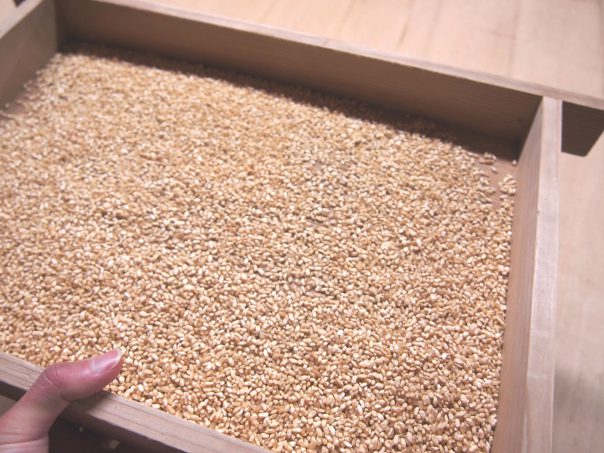
This is a rice malt of white rice called Hakumai Koji.

I could touch rice malt.
It was dried and smooth.
It takes about 3 days until the process of ferment is completed to make Koji.
Shubo Muro
Next place is Shubo Muro.
Shubo is a thing cultivated after adding yeast to the mix of steamed rice, Koji and water.
Shubo Muro is the place to make Shubo.
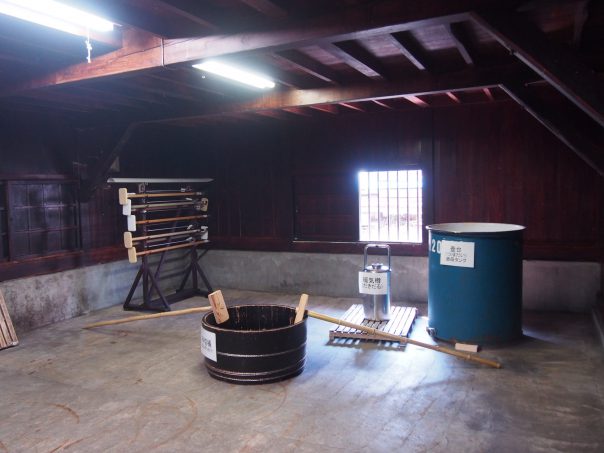
There are 2 ways to make Shubo.
One method is adding artificial lactic acid first (This is called Sokujo Method) and the other method is using natural lactic acid (This is called Kimoto Method).
Most of the sake produced in Japan is made using the former way.
Terad Honke apply latter method called Kimoto Shikomi or Kimoto Method by using natural lactic and microbe in the brewery to make Shubo.
Put steamed rice on to a wooden barrel and add Koji and water when the rice hardened.
After that, there is a process of grating using a wooden tool called Kaibou.
This is called Yamaoroshi.
Sake masters in Terada Honke do this Yamaoroshi by singing a traditional song called Matsuri Uta which is handed down generation to generation since old days.
You can see sake master singing the song in the video.

They say in the old days, there was no clock or watch that sake masters needed to measure the time and adjust the length of the work by singing a song.
The length of the song is decided by the sake master judging the conditions of the rice such as its hardness.
After Yamaoroshi, it is moved to Shubo tank and Dakidaru which contained hot water is put in shubo tank as well to adjust the temperature.
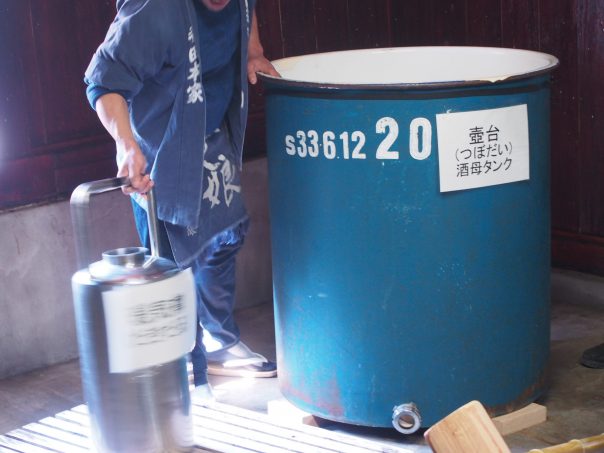
Temperature of this Shubo Muro is lower than other sake breweries because Shubo is made at low temperature at around 5 degrees Celsius.
It takes about 1 month to make Shubo.
Moromi Making
And next is Moromi Making.
Adding more Koji, steamed rice and water to Shubo and let them ferment.
Terada Honke apply three-stage mashing and it takes more than 30 days to make Moromi.

You can see big blue tanks right side in the picture and it is called Moromi Tank.
Microbes and molds inside tank are fermented to make unprocessed sake here.
By the way, what you can see in the center is a wooden barrel.
Now it is very rare to use wooden barrel to make Sake.
Because metal tank have taken the place of wooden barrel since around 1950.
Metal tank made the work easier and efficient but put a big pressure on the yeast at the same time.
It certainly takes time to take good care of wooden barrel but the yeasts inside ferment naturally because the heat conducted slowly.
Terada Honke hold a wooden barrel and make one of their sake by using it.
Which is Terada Honke Kioke Shikomi.
I tried it later and tasted very different than any other ordinary sake.
After that, compressing Moromi makes unprocessed Sake.
These are the part of the process, rather big part of the process of Sake Making Sake Master showed us.
Sake Tasting
I’ve already bought ticket so I’m gonna try some sake.

There are several booths for sake tasting.
I went for a booth of Terada Honke Kioke Shikomi first.
I needed to use 2 tickets here.
Looks like the number of tickets differs depends on the Sake you drink.

Yellowish sake.

I tasted and found that this is a unique taste.
Certainly I feel like this is made from a wooden barrel.
Yes, I know you want to say what is it like the taste of wooden barrel.
But it is difficult to explain the taste and you understand what I feel once you tried.
That was certainly unique and had Umami (delicious taste) in it.
I found Katori.
This sake I drunk before.

Musuhi!
This is my favorite!

My image of sake changed completely after trying this Musuhi.
This is sake of sprouted brown rice and microbes still alive inside.
So you need to keep it in refrigerator once you buy it.
Not only this sake but some of the sake of Terada Honke you have to keep in refrigerator because microbes alive.
Looked around and Kaikosyu caught my eyes!
I was attracted by the name.
To my surprise, this Sake is aged over 10 years.
And now I tried.

The color tells everything!

This was also first experience to me.
I’ve never tasted this flavor before.
Certainly this is very old sake, I can feel it from the taste.
Stronger taste than sake of wooden barrel but rich in flavor.
I like it, too!
Actually I’ve already completely drunk.
Just 2 small cups of sake is more than enough to make me drunk, haha.
But I still have one ticket left.
So I tried Shibotta Manma.
This is the last one.
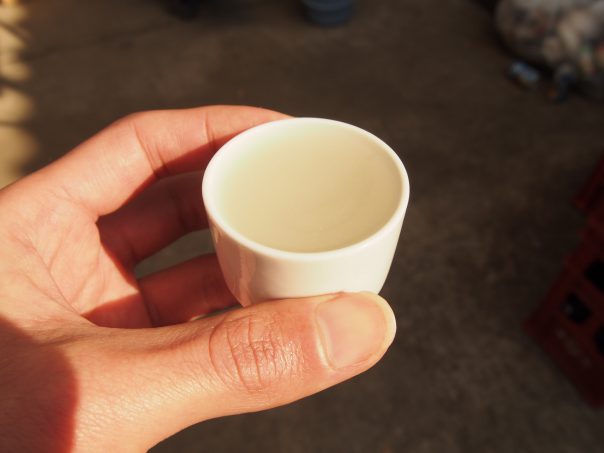
You can see the color is not clear.
This is Nigori Sake.
Nigori Sake is Cloudy Sake so very strong.
Local rice called Chiba Nishiki is used for this Sake.
This was certainly very strong but was good taste.
After enjoying Sake Tasting, I visited booth at which I could buy sake of Terada Honke for myself and friends.

I could choose from a wide variety of sake at the table.

After all, I bought Musuhi, Terada Honke Kioke Shikomi, Daigo no Shizuku.
This time I didn’t tasted Daigo no Shizuku because I’ve already tried it many times before but this is very popular sake and my friends also like it.
They were heavy so I wondered if I should use delivery service but I decided take them back home by hand after all.

Returned to the entrance, bought a book called Hakkoudou.
It is a book of head of Terada Honke.
This book had been on my mind for some time so this was a good timing!


Outside Again
There are many shops outside!

This shop Natural Harmony has a restaurant in Tokyo.

I can read Ufufu?
Looks like shop of Terada Honke.
Sake lees yeast doughnut and Amazeke (Sweet Sake) ice cream.
I’m curious!!

So I bought Amazeke ice cream.
Amazeke is a sweet sake and we enjoy it in winter.
There were kinako flavor and chocolate flavor.
Kinako is roasted soybean flour.
I went for Kinako.
Many granola on the top!

Oh, this is first time!
Certainly ice cream but taste of sake at the same time.
Interesting taste!
Organic apples.
Organic apple is very rare in Japan.

Drip coffee looks good!

Potteries.

I was spoken to like “Now you can buy this Ozenzai at 100 yen ($0.9)” by the staff of a shop.
So I bought Ozenzai.
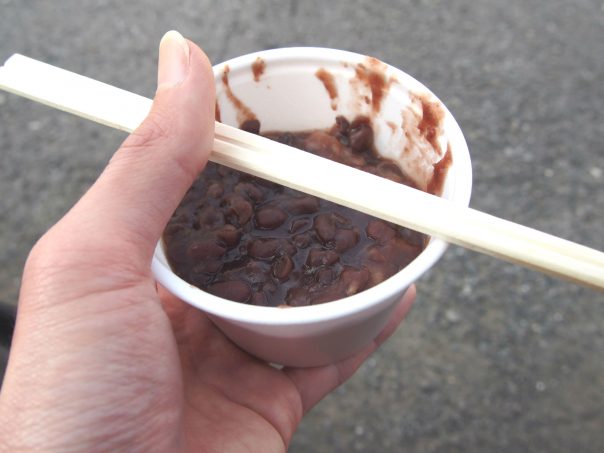
Ozenzai is a sweet red bean soup with a grilled rice cake.
We eat this Ozenzai especially in winter.
This Ozenzai was made using organically grown rice and red beans.
Not too sweet (usually Ozenzai is very sweet) and tasted very good!
It was discount price because this festival is soon over.
This is curry shop.
It says no chemical condiments curry.
This truck is cool!
Sadly the curry they sell had already sold out T T.

Instead I bought Suiton with sake lees.
Suiton is flour dumplings in soup.
But I’ve never seen Suiton with sake lees.

I liked the taste!

What?
Now I can hear sound of music from nowhere.
Looks like it is from around Terada Honke.
There was an open space next to Terada Honke and I could see people enjoying music.
Oh, the drummer of Taiko at the center is staffs or Sake Masters of Terada Honke.
I felt peace.


I was going to check other things and shops, too but the festival was over at 3:30.
I used free shuttle bus to the station when I went back as I was completely drunk, haha.
Summary
I enjoyed Okura Festa a lot!
I felt Sake of Terada Hoke reflects way of life of head master in Terada Honke.
They focus on manual work which takes time and actually not efficient.
Instead of using artificial thing they make use of microbes in the brewery.
They value coexistence instead of removing things for efficiency.
As I mentioned first, Terada honke or head was not like that first.
Rather opposite, he searched for efficient way by using machines and additives like other companies.
Because profit was very important and he was responsible of lives of his family and his staffs.
He can not shut down for them.
But one day he realized from all the experiences through time in Terada Honke, profit is not everything.
Then he decided to change the policy completely, that is completely opposite way by removing additives and machines as much as possible.
He did his best to make authentic sake even if it take time and cost a lot.
And it lead to today’s Terada Honke.
Actually I was worried if it is really OK to put all the details of sake process of Terada Honke in this blog and video.
Because some, or I think many, companies keep it secret.
Of course, I asked before shooting or taking picture if it is OK and sake master said it’s OK.
But still worried so I also made a call later just in case and they told me it’s OK.
I do not think to keep the process secret is a bad thing but I felt this openness reflects Terada Honke.
Terada Hoke gave me, who do not drink alcohol, a chance to touch sake, thanks for pleasant day!!
Terada Honke Okura Festa
Venue
1964 Kozakihonshuku, Kozaki, Katori District, Chiba
Closest Station
JR Shimosa-Kozaki Station
Website
https://www.teradahonke.co.jp/











